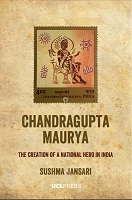Chandragupta Maurya
The creation of a national hero in India
Abstract
We take it for granted that some historical figures become heroes, and others do not. Chandragupta Maurya evolved from obscure ruler to contemporary national icon. The key moment in the making of this Indian hero was a meeting by the banks of the River Indus between Chandragupta and Seleucus, founder of the Seleucid empire and one of Alexander the Great’s generals, in c.305-3 BC. This significant event was a moment of peace-making at the end of conflict. But no reliable account exists in early sources, and it is not even clear which ruler was victorious in battle. This uncertainty enabled British and Indian historians of the nineteenth and twentieth centuries to interpret the sources in radically different ways. With Chandragupta representing India and Seleucus standing in for Britain, British scholars argued that Seleucus defeated Chandragupta, while Indian academics contended the opposite.
The writing and reception of history fundamentally influences how we engage with the past, and the evolving colonial and post-colonial relationship between Britain and India is crucial here. In India, the image of Chandragupta as an idealised hero who vanquished the foreign invader has prevailed and found expression in contemporary popular culture. In plays, films, television series, comic books and historical novels, Chandragupta is the powerful and virtuous Hindu ruler par excellence. The path to this elevated standing is charted in this book.
Keywords
India;Mauryan empire;Seleucid empire;British Raj;historical interpretation;Indica;Birla Mandirs;Indian films;popular icon;Hindi-language cinema;Bollywood;Tamil-language cinemaDOI
10.14324/111.9781800083882ISBN
9781800083899, 9781800083905, 9781800083912, 9781800083882Publisher
UCL PressPublisher website
https://www.uclpress.co.uk/Publication date and place
London, 2023Classification
History
Media studies


 Download
Download